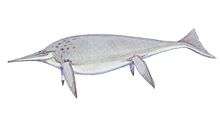Mollesaurus
Mollesaurus is an extinct genus of large ophthalmosaurine ophthalmosaurid ichthyosaur known from northwestern Patagonia of Argentina.[1]
| Mollesaurus | |
|---|---|
| Scientific classification | |
| Kingdom: | Animalia |
| Phylum: | Chordata |
| Class: | Reptilia |
| Order: | †Ichthyosauria |
| Family: | †Ophthalmosauridae |
| Subfamily: | †Ophthalmosaurinae |
| Genus: | †Mollesaurus Fernández, 1999 |
| Species: | †M. periallus |
| Binomial name | |
| †Mollesaurus periallus Fernández, 1999 | |
| Synonyms | |
|
Ophthalmosaurus periallus Maisch & Matzke, 2000 | |
Description
Mollesaurus is known from the holotype MOZ 2282 V, articulated partial skeleton which preserved partial skull and most of the vertebral column. It was collected in the Chacaico Sur locality from the Emileia giebeli ammonoid zone of the Los Molles Formation, Cuyo Group, dating to the early Bajocian stage of the Middle Jurassic, about 171.6-170 million years ago. Mollesaurus, along with Chacaicosaurus cayi which was found at the same locality, are the only diagnostic ichthyosaur specimens from the Aalenian-Bathonian interval. It was found near Zapala city of the Neuquén Basin.[1]
Maisch and Matzke (2000) regarded Mollesaurus to be a species of Ophthalmosaurus.[2] However, all recent cladistic analyses found that Mollesaurus is a valid genus of ophthalmosaurid.[3][4] Patrick S. Druckenmiller and Erin E. Maxwell (2010) found it to be the basalmost member of the ophthalmosaurid lineage that include Brachypterygius, Caypullisaurus and Platypterygius (but don't include Ophthalmosaurus).[3] Valentin Fischer, Michael W. Maisch, Darren Naish, Ralf Kosma, Jeff Liston, Ulrich Joger, Fritz J. Krüger, Judith Pardo Pérez, Jessica Tainsh and Robert M. Appleby (2012) found it to be the basalmost member of Ophthalmosaurinae.[5]
Etymology
Mollesaurus was named by Marta S. Fernández in 1999 and the type species is Mollesaurus periallus. The generic name is derived from the name of the Los Molles Formation, where the holotype was collected, and sauros, Greek for "lizard". The specific name is derived from periallos, Greek for "before all others", in reference to the fact that it is the oldest ophthalmosaurid and one of the oldest thunnosaurs.[1]
See also
- List of ichthyosaurs
- Timeline of ichthyosaur research
References
- Fernández, Marta S. (1999). "A new ichthyosaur from the Los Molles Formation (Early Bajocian), Neuquen Basin, Argentina". Journal of Paleontology. 73 (4): 677–681. doi:10.1017/S0022336000032492. JSTOR 1306766.
- Michael W. Maisch & Andreas T. Matzke (2000). "The Ichthyosauria" (PDF). Stuttgarter Beiträge zur Naturkunde. Serie B (Geologie und Paläontologie). 298: 1–159.
- Patrick S. Druckenmiller & Erin E. Maxwell (2010). "A new Lower Cretaceous (lower Albian) ichthyosaur genus from the Clearwater Formation, Alberta, Canada". Canadian Journal of Earth Sciences. 47 (8): 1037–1053. Bibcode:2010CaJES..47.1037D. doi:10.1139/E10-028.
- Fischer, Valentin; Edwige Masure; Maxim S. Arkhangelsky & Pascal Godefroit (2011). "A new Barremian (Early Cretaceous) ichthyosaur from western Russia". Journal of Vertebrate Paleontology. 31 (5): 1010–1025. doi:10.1080/02724634.2011.595464.
- Valentin Fischer; Michael W. Maisch; Darren Naish; Ralf Kosma; Jeff Liston; Ulrich Joger; Fritz J. Krüger; Judith Pardo Pérez; Jessica Tainsh & Robert M. Appleby (2012). "New Ophthalmosaurid Ichthyosaurs from the European Lower Cretaceous Demonstrate Extensive Ichthyosaur Survival across the Jurassic–Cretaceous Boundary". PLoS ONE. 7 (1): e29234. Bibcode:2012PLoSO...729234F. doi:10.1371/journal.pone.0029234. PMC 3250416. PMID 22235274.
[[Category:Jurassic

